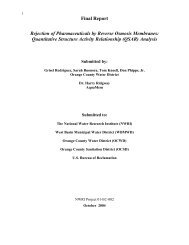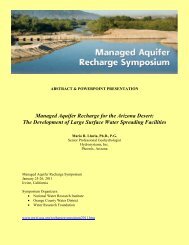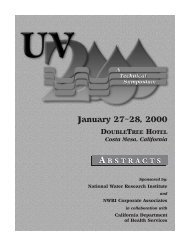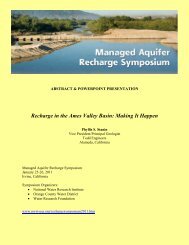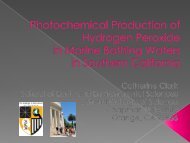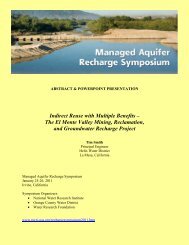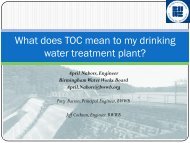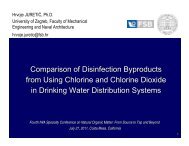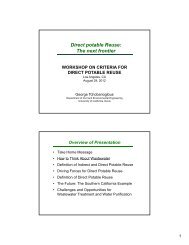RBF_Cover (for eps) - National Water Research Institute
RBF_Cover (for eps) - National Water Research Institute
RBF_Cover (for eps) - National Water Research Institute
You also want an ePaper? Increase the reach of your titles
YUMPU automatically turns print PDFs into web optimized ePapers that Google loves.
intuitive system behavior. In the case of <strong>RBF</strong>, such examples might be:<br />
• The reductive dissolution of iron oxides by DOC and the resulting release of sorbed<br />
heavy metals.<br />
• The assessment of pesticide mobility during flood events.<br />
Denitrification, degradation of pesticides, and dissolution of minerals are closely linked to DOC,<br />
a key component of river water whose concentration can vary depending on the season and flow<br />
events. Because of the reaeration process, river water is oxygenated compared to groundwater.<br />
During the induced infiltration process, oxygen-rich river water enters the aquifer, as does DOC.<br />
On its travel path, DOC from river water is oxidized and either mineralizes completely or is<br />
trans<strong>for</strong>med to intermediates through bacterial catalysis, together with the organic carbon that is<br />
perhaps naturally abundant in the aquifer as sediment-bound organic matter. Oxygen in<br />
the invading water is used as an electron acceptor in the process. Normally, there is sufficient<br />
carbon available <strong>for</strong> microbial use; however, oxygen can become in short supply along the flow<br />
path. Once microbes consume the oxygen, an anoxic zone develops where the nitrate of the<br />
infiltrating river water and groundwater is used as a substitute electron acceptor. This leads to the<br />
reduction of nitrate along the flow path. Once nitrate is also depleted, thermodynamically less<br />
favorable oxidized iron and manganese minerals and/or sulfate might act as alternative electron<br />
acceptors. Note that the simulation of the oxidation of one or multiple organic substrates using a<br />
sequence of electron acceptors is routinely applied in the field of bioremediation modeling, mainly<br />
where the transport and natural attenuation of oxidizable organic contaminants is simulated<br />
(Barry et al., 2002).<br />
The simultaneous simulation of <strong>RBF</strong>-typical denitrification and mineral dissolution reactions can<br />
be handled by a number of existing codes (<strong>for</strong> examples, see Table 1). One such code is EASY-<br />
LEACHER (Stuyfzand and Lüers, 2000), which was used to simulate reactions along a transect of<br />
the Torgau <strong>RBF</strong> site on the Elbe River in Germany. EASY-LEACHER is a two-dimensional<br />
reactive transport code in EXCEL spreadsheet, combining chemical principles with empirical<br />
rules in an expert system. The code was found useful to attain a first estimate of water quality in<br />
the production well <strong>for</strong> a <strong>RBF</strong> site where the operation of wells is started and <strong>for</strong> an easy<br />
calculation of different boundary conditions. In contrast to EASY LEACHER, which uses a<br />
collection of (one-dimensional) flow tubes to account <strong>for</strong> the transport of chemicals, the<br />
FEREACT model (see Tebes-Stevens et al., 1998; Tebes-Stevens and Valocchi, 2000) is a<br />
Table 1. Examples of Reactive Multi-Component Transport Models<br />
Model Reference<br />
CRUNCH Steefel (2001)<br />
EASY-LEACHER Stuyfzand and Lüers (2000)<br />
FEREACT Tebes-Stevens et al. (1998)<br />
PHT3D Prommer et al. (2003a)<br />
PHAST Parkhurst et al. (1995)<br />
MIN3P Mayer (1999)<br />
TBC Schäfer et al. (1998)<br />
HBGC123D Salvage and Yeh (1998)<br />
75



